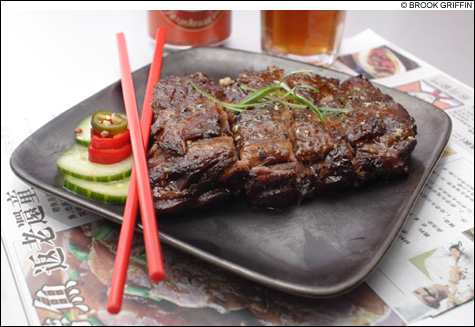
TEA-SMOKED PORK SPARERIBS: slow-roasted, then crisped with Sichuan peppercorns. |
Myers+Chang | 1145 Washington Street, Boston | Open daily, 11:30 am–11:30 pm | MC, VI | Full bar | No valet parking | Sidewalk-level access
617.542.5200 |
Chinese restaurants have given us so much flavor and value that it seems almost rude to point out that Boston hasn’t had a lot of luck with making them upscale. It’s even more daring for a Chinese restaurant to try to go higher-end within a few blocks of Chinatown. As evidenced by Peking Tom’s, to cite a recent attempt, it’s hard to capture the slight campiness of Chinese-American restaurants with enough affection to avoid satire or borderline racism. It’s also surprisingly tricky to fuse Chinese food, even with other Asian cuisines. And when you get to working in European ingredients and techniques, well, there’s Ming Tsai, and there’s everybody else. Myers+Chang is a far surer effort than Peking Tom’s, both in the kitchen (which also draws from other Asian cuisines) and in the design, which is modernized, more spacious, and louder. But it retains enough of the traditional signifiers to make your mouth water for spring rolls, spareribs, and Peking ravioli.So let’s start right there. Mama Chang’s pork and chive dumplings ($11) are the best Peking ravioli I’ve ever tasted, including those from a Chinese-cooking class taught by a recent ex-pat. I don’t know if it’s the family recipe (co-owner Joanne Chang’s mother is from Taiwan) or the chef’s modifications of it that makes them so good. But these five dumplings had the meatiest flavor, the gingeriest undertone, the most perfectly just-charred thin skins, and the most intense garlic-soy dip ever. Tea-smoked pork spareribs ($12) are a somewhat bigger portion, but a much more unusual treatment. They’re slow roasted or poached to falling-apart texture, smoked, and then crisped with Sichuan peppercorns and garlic so they have a crust. If that’s not enough for you, they’re served with a few slices of pickled hot peppers. The spring rolls ($5) come to the table piping hot (which makes the greasiness taste best), with a filling of earthy vegetables (maybe a little seaweed in there?), a thin crisp skin, and an intensely gingery dip.
These aren’t strictly appetizers, because the menu isn’t divided that way, and because the service strategy is to bring everything to the table whenever it comes out from the kitchen. But you can already see why this restaurant succeeds. They can play with the recipes, raise the prices, reduce the portions, and get away with it because they know the important things about the food.
Winter always turns a Chinese-food lover’s thoughts to clay-pot dishes, and the striped bass clay pot ($18) is about as close as Myers+Chang comes to a real entrée. The piece of wild striped bass is what a bistro would serve, but the added clams, black mushrooms, and miso-ham broth make a fabulous soup-stew, and perhaps a richer stock than a traditional clay-pot recipe. The other deviation from tradition is the brown rice ($2 as a side dish) included in the clay pot.